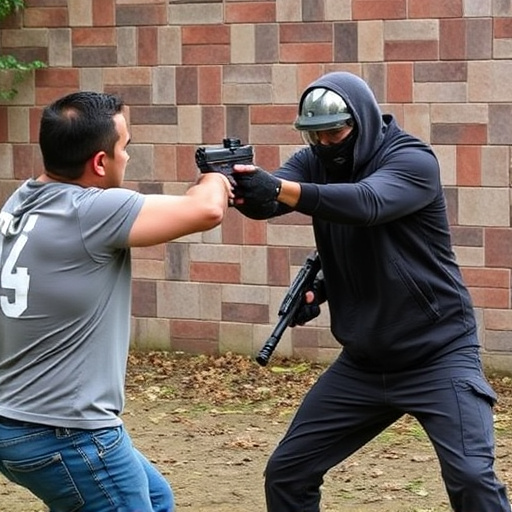Non-Lethal Stun Guns Online: Understanding Voltage Penetration Through Clothing
Understanding voltage dynamics between non-lethal stun guns and clothing materials is crucial for ef…….
Understanding voltage dynamics between non-lethal stun guns and clothing materials is crucial for effective self-defense. Dry cotton offers higher resistance than damp or synthetic fabrics, impacting shock delivery. When purchasing online, consider voltage output, weight, and range while adhering to local laws to ensure safe use of these devices without causing harm through excessive voltage. Reputable sellers offer high-voltage models that meet industry standards, promoting responsible usage and de-escalation techniques for ethical deployment.
“In today’s digital age, understanding voltage penetration through thick clothing is a critical aspect of online safety. This article delves into the intricate world of electrical conduct, focusing on non-lethal stun guns and their effectiveness. We explore factors influencing clothing penetration, emphasizing the importance of choosing the right equipment. Additionally, ethical considerations and legal frameworks surrounding these devices are discussed. Remember that in the realm of online security, knowledge is power.”
- Understanding Voltage and Its Behavior
- The Effectiveness of Non-Lethal Stun Guns
- Factors Influencing Clothing Penetration
- Choosing the Right Equipment for Online Safety
- Ethical Considerations and Legal Frameworks
Understanding Voltage and Its Behavior

Voltage, a crucial measure of electrical potential difference, plays a fascinating role in various applications, including non-lethal stun guns available online. When it encounters thick clothing, its behavior becomes a subject of interest and concern. The penetration capability of voltage through fabric can vary greatly depending on factors such as the type of material, thickness, and moisture content. For instance, dry cotton clothing may present a higher resistance to electrical flow compared to damp or synthetic fabrics, which can conduct electricity more readily.
Understanding how voltage interacts with different textiles is essential for evaluating the effectiveness of non-lethal self-defense tools like stun guns. Online research into these products often highlights specifications related to voltage output and penetration depth as key factors in their performance. This knowledge allows users to make informed decisions when purchasing such devices, ensuring they meet the desired level of protection against potential threats while considering the limitations posed by clothing materials.
The Effectiveness of Non-Lethal Stun Guns

Non-lethal stun guns have gained significant attention in recent years, particularly among those seeking personal protection options available online. These devices are designed to incapacitate an assailant temporarily without causing permanent harm, making them a popular choice for self-defense advocates. The effectiveness of non-lethal stun guns lies in their ability to deliver a powerful electric shock that disrupts the body’s muscular control, leading to temporary paralysis and disorientation.
When shopping for non-lethal stun guns online, it’s crucial to consider factors like voltage output, weight, and range to ensure optimal effectiveness. Higher voltage levels generally result in more powerful shocks, increasing the likelihood of incapacitating an attacker quickly. However, it’s essential to balance this with safety considerations, as excessive voltage could potentially cause injury or even be lethal if used irresponsibly.
Factors Influencing Clothing Penetration

Several factors determine how effectively voltage, particularly from non-lethal stun guns, can penetrate thick clothing. The electrical current’s path and strength depend on the material composition and thickness of the fabric. Different textiles conduct electricity differently; for instance, synthetic materials like polyester generally allow current flow better than natural fibers like cotton. The resistance encountered by the electric charge increases with fabric density and thickness, potentially reducing its penetration depth.
Additionally, the design and construction of the garment play a role. Pockets, seams, and other crevices can create conductive paths, enhancing current flow through certain areas. Moisture content in the clothing can also impact conductivity, with wet fabrics typically facilitating better electricity transmission. The specific type of non-lethal stun gun used is another critical variable; higher voltage devices may overcome resistance more effectively than lower settings. Factors like these underscore the importance of understanding clothing materials when considering the efficacy of non-lethal stun guns purchased online.
Choosing the Right Equipment for Online Safety

When it comes to ensuring online safety, especially in potentially volatile situations, the right equipment can make all the difference. One crucial tool to consider is a non-lethal stun gun, designed for self-defense and to incapacitate without causing permanent harm. These devices are becoming increasingly popular as a safe alternative to firearms, particularly for individuals who want to protect themselves while adhering to legal restrictions on lethal force.
When purchasing a non-lethal stun gun online, it’s essential to choose a reputable seller and opt for models that meet industry standards for safety and effectiveness. Look for features like high voltage output, a compact design for easy carrying, and durable construction to withstand various conditions. Additionally, familiarizing yourself with local laws regarding stun guns is vital before making a purchase to ensure compliance and peace of mind.
Ethical Considerations and Legal Frameworks

When exploring voltage penetration through thick clothing, it’s crucial to navigate the ethical and legal landscapes surrounding non-lethal stun guns available online. The use of such devices raises important questions about personal safety, consent, and potential unintended consequences. Online platforms offering non-lethal stun guns must ensure transparent communication about their products’ capabilities and limitations, especially regarding clothing materials as barriers to effectiveness.
Legal frameworks vary globally, with some jurisdictions permitting the sale and carrying of stun guns for self-defense while others strictly regulate or ban them. Users and sellers alike bear the responsibility to comprehend local laws, ensuring compliance to avoid legal repercussions. Ethical considerations also extend to promoting responsible use, emphasizing de-escalation techniques and understanding when a stun gun is truly necessary.
Understanding how voltage travels through clothing is essential in choosing the right safety equipment, especially when considering non-lethal stun guns for online interactions. The effectiveness of these devices depends on various factors, including clothing material and thickness. By understanding these influences, users can make informed decisions to ensure their safety while navigating the digital world. Ethical considerations and legal frameworks also play a crucial role in ensuring responsible use of such technology, especially as non-lethal stun guns gain popularity for personal protection online.


